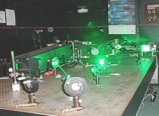|
|
| Research potential |
|
| |
|
The Centre offers its advanced experimental and theoretical tools for conducting research aimed at solving problems in some specific areas of science and technology. A set of experimental techniques that are available in the Centre consists of:
- A family of optical spectroscopy methods for studies of condensed matter with particular emphasis on optical phenomena in solid state, defects in semiconductors, and insulators, low dimensional structures, nanocrystals:
q the high resolution Fourier Transform Infrared Spectroscopy in absorption and luminescence modes,
q photoluminescence excitation spectroscopy in the visible and the near-infrared,
q photoluminescence under high pressure in a diamond anvil cell.
- A family of magnetic resonance techniques which include:
q a standard electron spin resonance (ESR) setup, photo-ESR and ESR under pressure for studies of solid state as well as of biological systems,
q the unique 60 GHz setup for optically detected magnetic (ODMR) and cyclotron resonance (ODCR),
- The most advanced capacitance spectroscopy techniques for studies of deep level centres in semiconductors, namely Laplace Transform DLTS (Deep Level Transient Spectroscopy) and DLTS under uniaxial strain, which allow identification of the local atomic environment and the symmetry of deep centres.
- Nonlinear optics, four wave mixing for holographic recording in photonic materials.
- A broad range of spectroscopic techniques for studying molecular sysyems including stratospheric pollutants, biologically relevant intermolecular complexes, nucleic acid bases involved in DNA transcription errors, and 'single molecules' in low temperature crystals:
q vibrational spectroscopy under the matrix isolation conditions, allowing studies of e.g. photochemical transformations of nucleic acid bases and their derivatives of biological importance,
q several types of spectroscopy of electronic transitions, including "single molecule", cavity ring-down, and supersonic expansion techniques,
q rotational spectroscopy of weakly bound intermolecular complexes in supersonic expansion, and of stable molecules of chemical, atmospheric and astrophysical importance.
- Advanced spectroscopic techniques for studying atoms, diatomic and chaotic systems. These include:
q polarisation labelling spectroscopy of diatomic molecules and determination of precise molecular potentials,
q microwave spectroscopy aimed at investigation of new classes of quantum chaotic systems (e.g. ray-splitting systems),
q spectroscopic studies of excitation transfer induced by collisions with atoms,
q two-photon spectroscopy of atoms,
q theoretical studies of quantum state engineering and of properties of Bose-Einstein condensates.
- Microscopes of atomic and magnetic forces, for visualisation and mapping.
- Tunnelling spectroscopy - the crucial technique for studying quantum transport in thin multilayer structures of semiconductor-ferromagnetics, and in many other systems.diagnostic of atmospheric dusts related to preventative health care.
- The Institute of Physics of the Polish Academy of Sciences has a very well developed material base for scientific work. The entire Institute is covered by a helium recovery installation. Institute has own helium liquefier and is able to continuously supply liquid helium for experiments. The Institute also has its own liquid nitrogen liquefier and a related supply system, which is of great importance for smooth running of thin layer molecular beam epitaxy deposition systems, as well as many other experimental installations.
back to top |
|
|
|





 Contact persons
Contact persons